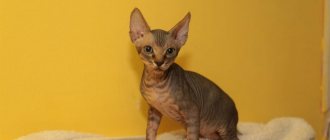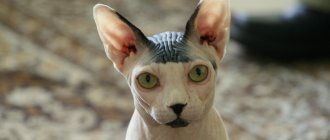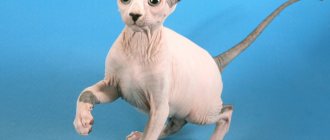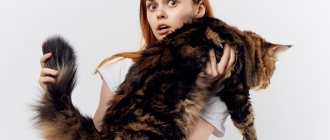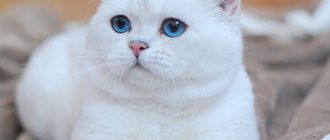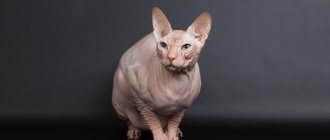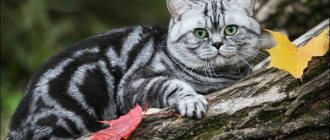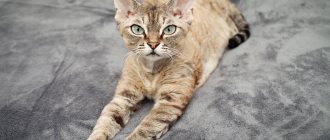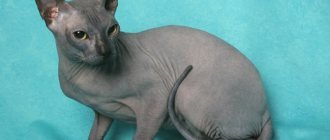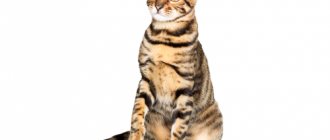Despite their atypical appearance for felines, sphinxes continue to win our hearts, becoming more and more popular among cat lovers every year. However, hairless cats continue to be quite rare due to the limited gene pool.
Why the Sphynx cat is still a curiosity, where hairless cats come from, what kittens from a Sphynx and an ordinary cat will be like, as well as many other features of the breed varieties will be covered in this article.
Varieties of Sphynxes - breeds with photos and names
If you still think that the Sphynx is one breed, then this article is for you. Officially, felinological associations recognize three varieties of hairless cats. We will talk about them in this article.
Note! There are also breeds of hairless cats that are not recognized by felinological associations. For example, the Bambino (a cross between the Sphynx and the Munchkin) and the Ukrainian Levkoy.
Canadian Sphynx (moon cat)
Canadian hairless cats have become the standard among other branches of hairless cat breeds. The founder of the breed in 1975 was a completely hairless kitten born from a short-haired mother.
A little later, his hairless sister was added to the first one, born a year after the significant birth of the most famous hairless cat. The naked babies were bought by the Z. Stardust nursery, the first hairless kittens became the founders of the most elite branch of the breed, their descendants are distinguished by their impeccable exterior and unparalleled “velor” skin.
Don Sphynx
Donchak is a much younger breed than Canadians. Don or Rostov hairless cats are a domestic breed, bred in Rostov-on-Don, recognized much later than their hairless overseas relatives from Canada. As an independent breed, Rostov Sfin cats received recognition in 1980.
Peterbald (Petersburg Sphynx)
One of the youngest branches of the Sfin cat breed is considered to be a breed bred in St. Petersburg. A new branch was created by crossing an Oriental cat and a Donetsk Sphynx in 2003.
Health and life expectancy
Sphinxes have a strong immune system, but there are also a number of diseases that are inherited:
- Myopathy – weak neck muscles; during life, the entire muscular system may weaken.
- Heart failure.
- Airway obstruction.
Such diseases appear at an early age, and the breeder must notify them in advance.
Sphinxes are also prone to the following diseases:
- turning of the eyelids;
- vasculitis – reddish or bluish dots appear on the skin;
- acne – appears due to strong production of subcutaneous sebum;
- conjunctivitis;
- dermatitis.
If properly maintained, the average lifespan of a Sphynx is 14–17 years.
Features of cats without hair
According to legends, the Egyptian Sphynx cat escorted the souls of the inhabitants of Ancient Egypt to the afterlife. According to legends, among the Aztecs, unusual hairless cats with large ears evoked reverence and respect. Allegedly, Aztec cats lived at temples, and the Aztecs revered hairless cats with large ears as divine beings.
The owners of modern Sfin cats jokingly prefer to classify their pets as alien creatures. Some owners simply say that sphinxes are magical cats. By the way, it’s hard to disagree with this statement. Everyone has long known the healing abilities of cats: cats find a sore spot on their owner, diligently knead it, massage it, and then lie down on the source of pain to warm it with their natural warmth. So, among Sfin purrs, these abilities of home healers are doubled due to the contact of the hot skin of a hairless cat with human skin.
Cats without fur need to be fed more often than their furry relatives. To maintain the necessary thermal balance of the body, the Sfin cat requires more frequent feeding and much more food than a purring cat with fur.
Sphynx body temperature
As for small hairless kittens, the normal temperature for them is 38.5-39.5⁰C. Metabolism in babies is higher, metabolic processes occur faster than in adult animals, therefore the normal body temperature in kittens is higher than in mature individuals.
In adult hairless cats and hairless cats, the normal body temperature is 38-39⁰C.
Do sphinxes have mustaches?
Many sphinxes either have no whiskers at all, or they are broken off or curled. In some Sphynx cats the whiskers fall out and grow back. Moreover, the process of loss and regrowth of whiskers in Sfin cats is a very individual matter, not amenable to any predictions.
In the language of zoologists, cat whiskers are called vibrissae; for purrs, this simple-looking device works both as protection from external dangers and as a means of navigation.
Cats are nocturnal animals and love to hunt in the dark. To recreate a complete picture of the environment, the cat uses sensitive antennae, with which it is able to detect air currents and vibrations.
If a cat's whisker touches any object, the purr will immediately trigger a defensive reaction - the cat will reflexively close its eyes. What if the obstacle touched by the vibrissa turns out to be a sharp branch, wire or some other dangerous object? Nature took care of the soft-footed meowing hunters, providing them with an additional organ of touch in the form of sensitive vibrissae.
Any Sphynx cat, although a representative of the cat family, is not a night hunter. A hairless cat is unable to survive either in the wild or on the street: it is an exclusively decorative creature bred to be kept at home. Such a pampered, whimsical animal does not particularly need a hunting attribute in the form of sensitive long whiskers.
Sphinx tail
The tail of a healthy animal should be flexible and mobile, thick at the base, gradually tapering towards the tip. Sphinxes often curl their sensitive whip-like tail into a ring, which adds even more mystery and piquancy to their unusual appearance. At the tip of the tail, sphinxes are allowed a “lion tassel” - a small tuft of hair.
Unfortunately, this part of the body in hairless cats can be problematic and bring a lot of inconvenience to the pet and its owner.
- Problem one: Anomalies, deformations and other defects of the tail, both congenital and acquired. A Sphynx of any breed that has an underdeveloped, deformed or broken tail will not be allowed for breeding. But that’s not so bad – not all pets can be the stars of a show. The trouble with congenital tail deformation is that a “broken” tail may turn out to be the tip of the iceberg, under which many diseases are hidden that threaten the health and even the life of the animal.
- Problem two: Angular cystic acne, acne, comedones. Both young animals during puberty and mature animals actively involved in breeding are susceptible to these unpleasant skin diseases.
The first of these misfortunes disfigures the cat's tail; angular cystic acne results in persistent scars that are almost impossible to remove with any absorbable ointments.
On the affected areas of the skin, cystic cavities filled with pus are formed; the inflamed foci can merge with each other and open out through the fistula tracts. The disease lasts a long time; a shell of keratinized skin particles and exudate forms on the inflamed areas.
Acne and comedones are more often observed in hairless (rubber) cats. To prevent acne, hairless animals are bathed in a decoction of chamomile or string. Also, do not forget to regularly wipe your pet’s tail with a special degreaser.
Do Sphynxes have fur?
Yes, there are.
According to the breed standard, only the Canadian Sphynx does not have varieties with fur. The animal's skin should have only minimal invisible fluff. There is short pubescence on the muzzle.
But domestic cats - the Peterbald and the Don Sphynx - according to the breed standard, allow individuals with different types of hair. We will talk about them in detail in the next section.
Did you know that a hairless cat can give birth to a fluffy kitten? In some individuals it falls out over time, while others remain fluffy.
Types of Sphynxes with fur
These types apply only to St. Petersburg and Don sphinxes:
- Brush . The coat of the Brush species can be either hard or soft and silky to the touch. The length of the hair is 2-3 mm. The coat can be straight and wavy, or crimped and hard, reminiscent of an old brush that has served its purpose.
- Flock . The skin of a flock animal is covered with tiny short hairs, reminiscent to the touch of a peach skin. As a rule, flock cats walk “in clothes” made of peach fluffs until they are 1.5-2 years old, then they completely “undress”.
- Velor . If you touch a velor seal, you are left with the feeling of touching velor or thin, very high-quality suede. The length of the hair is 2-3 mm. The fibers of velor individuals are much more noticeable than the tiny flock, barely visible to the human eye.
Why are sphinxes bald?
Genetics played a major role in the development of hairless cat breeds. Sphynxes are cats without hair, bald, cute mutants with an unusual appearance caused by the hairlessness gene. This mutation gene has long been tested by felinologists for stability, however, a hybrid of a Sfin cat and an ordinary cat is not always born bald.
Appearance of the Sphinx
Sphynx kittens
Sphynxes are not large breeds. Females usually weigh 3.5-4 kg, males weigh between 5-7 kg. At the same time, the body is muscular and dense, which is why cats actually turn out to be heavier than one might expect given their size. The skin is thick and gathers into characteristic folds, especially pronounced on the muzzle.
Head
Medium in size, shaped like a slightly rounded modified wedge, where the length is slightly greater than the width. The forehead is flat, the transition from it to the muzzle can be either quite soft or clearly pronounced. The muzzle is short. The cheekbones are high and clearly defined. The chin is strong and forms a perpendicular to the upper lip. The nose is short, with a slight to medium stop. The whisker pads are well developed, although the whiskers themselves are completely or almost completely absent.
Ears
Ears are one of the distinctive features of the Canadian Sphynx breed. Very large compared to the head. Upright and open. The base is wide. The inner surface is without wool.
Eyes
The eyes of sphinxes are large, shaped like a lemon, because with a wide middle part they narrow equally on both sides. Set wide and slightly slanted. The color is not regulated, but must be in harmony with the color.
Neck
Medium length, slightly arched, with well-developed muscles.
Face of the Canadian Sphynx
Body
Sphynx paws
The body of the sphinx is of medium length, muscular. The chest is wide and rounded. The belly is round and full. The back of the body is rounded.
Legs
Medium length, proportional to the body. Strong and muscular. The hind ones are slightly longer than the front ones.
Paws
Oval, with thick pads and well-developed long toes.
Tail
White Sphynx
The length of the Sphynx's tail is proportional to its body. Graceful and flexible, gradually tapering from base to tip.
Cover and skin
The skin of the Canadian Sphynx is thick and forms folds, which are especially numerous on the face and legs. They seem completely hairless, but usually the body is covered with delicate down (a length of no more than 2 mm is allowed). The norm is the presence of short, sparse hair on the outside of the ears, tail, between the toes and in the scrotum area. The bridge of the nose is covered with the usual short hair for cats.
Color
Despite the lack of hair in the usual sense, sphinxes have many colors: white, black, red, chocolate, lilac (lavender), tabby, tortoiseshell, two-color, calico (tri-color), color point, mink. Neither conflicts with the CFA standard.
How does a Sphynx get along with other cats?
Hairless cats and cats get along well in pairs with individuals of their own species. Touchingly hugging their paws, they love to cuddle, lick each other and show mutual care in every possible way.
Sphynxes have a friendly character, so they do not get into trouble with other pets and do not arrange for division of territory. The only thing that a bald cat cannot share with another cat is the love of its owner. Sfin cats require more attention to themselves than other pets.
“Master, have as many cats as you want, but love only me!” - this is the motto of the naked cat.
Cost and principles of choice when buying kittens
The cost is affected by the presence of defects such as:
- underdeveloped muscles;
- small ears;
- muzzle is too long or too narrow;
- the presence of fur in some areas of the body, more than 3 mm.
The price for each Sphynx kitten is set individually by the breeder - first of all, it depends on the pedigree and the opportunity to take part in exhibitions in the future. Buying such a pet will cost on average $600–1000. The cat is sold together with a passport, vaccination certificates and pedigree.
If you have no plans for exhibition activities, you can find a baby for 100–300 dollars - these animals have some external defects that do not meet the standards.
How much does a hairless cat cost - price in Russia
Only three breeds of hairless cats are officially recognized by feline dog associations:
- Canadian Sphynx. The price of a kitten, depending on the class and elite status of the parents, varies from 8 to 100 thousand rubles.
- Don Sphynx. The price of a kitten varies from 9,000 rubles to 30,000 rubles.
- Peterbald. The cost varies from 5 to 25 thousand rubles.
There are also unrecognized breeds of hairless cats, for example, the Ukrainian Levkoy or the Bambino. However, despite the “unrecognition”, you won’t be able to buy a hairless cat on the cheap. Bambino will cost an average of 20-50 thousand rubles, and Ukrainian Levkoy - 10-20 thousand rubles.
Rules of care and maintenance
Recommendations for caring for sphinxes:
- Pets do not have eyelashes, so the cornea is more often washed with tears mixed with dust. Because of this, brownish discharge appears in the corners of the eyes, which should be removed with a piece of gauze or a cotton pad soaked in chilled black tea.
- Sphynxes are characterized by excessive secretion of skin lubricant and secretions in the ears. The ears should be carefully treated with a cleansing lotion, and then remove dirt with a cotton pad. You should not penetrate deep into the sink so as not to impair your pet’s hearing.
- It is recommended to bathe the cat at least once a month, otherwise skin discharge will remain on everything the animal touches. In addition, a peculiar odor will begin to emanate from his body. Washing is carried out with animal shampoo - human cleansing compositions are not suitable for use, as they lead to a violation of the pH of the skin. If an excess of brownish plaque with an unpleasant odor appears on the skin, you need to visit a veterinarian - most often, the problem lies in an unbalanced diet.
- The claws are trimmed with a nail clipper several times a month - in sphinxes they grow back quite quickly. During a manicure, you need to carefully remove any secretions that have accumulated in the nail bed with a damp cloth or cotton wool.
Due to the lack of fur, cats easily become hypothermic, so the owner must always monitor the temperature in the house and buy the pet a house and special clothing in advance.
The Sphynx can stay in the sun for a short time - this will give its skin a golden hue. But prolonged sunbathing will cause burns.
Pros and cons of sphinxes
Positive aspects include the high intelligence and docile nature of hairless cats, their affection and devotion to their owners - it’s not for nothing that sphinxes are called “kissing” cats.
Some breed lovers consider the negative aspects of keeping sphinxes to be their increased love for tactile contact. Occasionally this “alien miracle” shows excessive intrusiveness; not all people will like a cat’s butt sitting on their own face. By placing his hot butt on the owner’s head, or even on the owner’s “face,” the naked cat believes that in this way he will express his boundless love much more clearly. And you will have to come to terms with this - the cat is a “kisser”...
Tabby color (tabby) and its shades
| Classic spotted | There are clearly defined spots on the sphinx's paws and tail. The pattern is scattered over the entire body, with the exception of the tummy. |
| Mackerel/Tiger | A spotted pattern resembling stripes clearly marked on the tail and legs. Stripes are present throughout the body and on the head. |
| Marble | The spots can have a round, oblong shape, repeating the pattern of marble. |
| Silver | Pale transparent silver color. The spots and stripes are densely black. |
| Brown | Copper-brown shade, shiny. The markings are solid black. The hindquarters of the Sphynx's legs are black. |
| Blue | It has a pale bluish tint, closer to ivory. Dark blue markings provide good contrast. |
| Cream | The skin is pale cream. The marking shade is darker than the base color, which provides contrast. |
The history of the origin of the breed - how hairless cats appeared
The first Don Sphynxes appeared from a half-haired cat of unknown origin, which was found in a trash heap by a kind-hearted Rostov woman. The woman tortured the found half-sphynx with procedures aimed at restoring the fur until she came to terms with the fact that no medicines or ointments help return the coveted fur to the found purr. In the end, the pussy was left alone, and later she brought hairless kittens from an ordinary short-haired cat, which became the founders of the breed of the first domestic sphinxes.
A similar story happened in Canada, when a hairless mutant kitten was accidentally discovered on a farm. “Rostovite” and “Canadian” are two opposite branches that have different genotypes; these two types of sphinxes do not cross with each other.
There are persistent rumors among felinologists that the first hairless cats could have appeared much earlier than the relatively new breed of hairless cats - the Canadian Sphynx cat. Strange cats without hair were noticed by the British at the beginning of the last century, but then there were difficult times in England, people were not interested in breeding “mutants with an alien appearance.”
How to choose a kitten
The main advice is the same for all purebred animals: do not try to save money on your purchase by going to the “bird market” or responding to a random ad. Only the best nurseries and breeders with an impeccable reputation will guarantee that you will receive a healthy pet, the origin of which cannot be doubted. After all, the Canadian Sphynx is not just a lack of hair, but a graceful, beautifully built, affectionate and intelligent creature that will live next to you for the next few years.
If you do not plan to participate in exhibitions, it is enough to make sure that the chosen baby is healthy and active, easily makes contact with people, without showing fear or aggression. The rest will be determined by the available documents (pedigree, veterinarian’s report, vaccination card). We recommend getting to know the parents and looking at the living conditions - they will say a lot about the breeder’s attitude towards the cats.
Interesting facts about Sphynx cats
- A naked cat is a “kissing” cat! The owner of a loving Sphynx should come to terms with this fact, because a hairless pet constantly requires communication and tactile contact. Sfin cats love to lick the hands of their owners - this is how they show their love.
- Sfin cats are extremely jealous. No, they are not at all against other pets. It's just that hairless cats want their owner to love the Sphynx more than other pets.
- Hairless cats love to cuddle.
- In addition to the well-known types of breed varieties (Canadian, Donskoy, Peterbald), there are several interesting varieties of hairless cats - Bambino, Ukrainian Levkoy, Elf, Dwelf, Cojona, Minskin.
- What kind of kittens will be born if you cross a Sphynx with an ordinary cat? Mixed half-sphinxes will be attractive in appearance, but they are unlikely to fully meet the breed standard - in this case, outbred genes will not add advantages to the animal’s exterior. However, kittens born from a half-sphinx will be carriers of the hairless gene.
The character of the Canadian Sphynx
The ancient sculpture of a lion with a human head, lost in the African sands, was once called differently by Arabic speakers - Abu al-Haul, that is, the Father of Terror. But her little namesakes don’t seem at all intimidating to their owners. These are real “tails” that will follow a person everywhere and will not miss the opportunity to settle on his lap.
This sphinx has found its place
However, such affection is not at all an indicator of laziness. Sphinxes are very mischievous and playful creatures; they get involved in active fun with great excitement or independently come up with entertainment for themselves, such as “hunting” for a beetle that happens to be in the apartment. Games should be versatile and challenge not only dexterity and muscle strength, but also the intellect.
Sphinxes do not tolerate loneliness well, which should be taken into account by potential owners whose work involves frequent and long business trips. Canadians are attached not to a place, but to “their” people, so separation is a difficult test for them, even if in your absence the care of your pet is entrusted to reliable and kind hands.
Sphynxes are absolutely not aggressive, so they get along well with children of different ages and calmly share their home with other pets. Moreover, they know how to be friends with both cats and dogs, which helps brighten up the long hours of waiting to meet a person.
Representatives of this breed get used to being in large crowds of people quite easily. Thanks to this, sphinxes feel good at exhibitions, and some bring the skill of equanimity to such a level that they become real movie stars. The most striking example of this is Ted Nugent, who played the role of Mr. Bigglesworth, Dr. Evil's cat from the famous Austin Powers film series.
Photo
Where's the wool?
A special feature of the Sphinx is its fur, or rather its absence. Why are Egyptian cats hairless? According to felinologists, this is due to a natural mutation of the gene responsible for fur, which was later fixed by crossing with short-haired animals. In fact, the descendants of Egyptian hairless cats have hair on their skin, but it is so short and thin that it is impossible not only to see it, but also to feel it when stroking the Sphynx.
Sometimes there is pubescence on the face, ears, tail, paws and groin. These animals do not always have eyebrows and mustaches.
Price of Don Sphynx kittens. Where to buy a Don Sphynx cat. Don Sphynx nurseries
Unlike some recently emerging cat breeds that are just achieving world fame, Don Sphynx cats became popular almost immediately. Both in Europe and the USA, and in the CIS countries, many nurseries offer to buy wonderful Don Sphynx kittens that meet the standard and all the expectations of future owners.
The price of Don Sphynx kitten ranges from nine to thirty thousand rubles.
The cost depends on various factors, including the reputation of the nursery.
If you take Don Sphynx kittens from breeders, the most reasonable price in this case is about ten thousand rubles.
Don Sphynx nurseries:
- MY TOYS;
- Ramses.
Intelligence
All Sphynx breeds are easy to train; their memory, logic and character are sometimes equated to the level of trained dogs. After several trainings, the animal is able to perform tricks: it will bring small objects to its owner in its teeth, learn to open doors, drawers and even the lid of a washing machine. Kittens remember their name the first time.
These creatures are naturally very inquisitive and sociable, which allows them to socialize easily. An unusual pet will definitely make friends with all members of your family; they cannot stand conflicts.
- Author: Elena Romanenko
Rate this article:
- 5
- 4
- 3
- 2
- 1
(8 votes, average: 2.9 out of 5)
Share with your friends!
Hairless cat health
When purchasing a defenseless, wrinkled, naked kitten, owners should know that at home, with good care, Sphynx cats live on average about 14 years, and they need special care. Due to the lack of fur, these animals are sensitive to climate and weather changes. They cannot easily tolerate extreme cold or heat.
Sphynx cats suffer from hyperhidrosis. Impurities and oil deposits accumulate on their skin. Therefore, it should be wiped regularly with a damp sponge.
Hairless cats are prone to developing allergic reactions that manifest as skin rashes.
